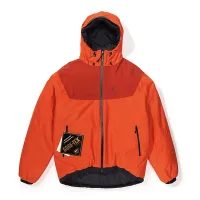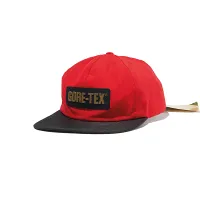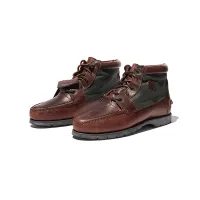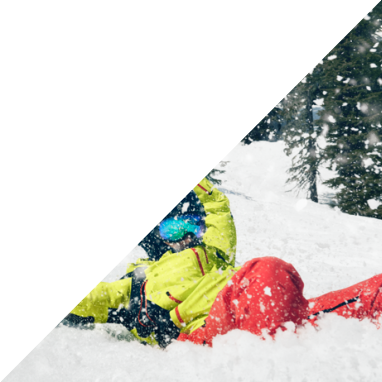
SELECTED MEMORIES OF FUNCTIONALITY: PROCELL NEW YORK
Jessica Gonsalves and Brian Procell, the pair behind the city’s most influential vintage hub PROCELL, have curated a one-of-a-kind collection of vintage GORE‑TEX outerwear, footwear, accessories, as well as never-before-seen memorabilia.
“Selected Memories of Functionality” was conceived to invite contributors from different industry segments to share personal experiences with the GORE‑TEX Brand in their past or present, as well as anecdotes about weather, climate, and comfort. The series offers insights into the qualities that GORE-TEX technologies have brought and continue to bring to functional lifestyle- and fashion products. In 2019, London-based stylist Stephen Mann was given the opportunity to display some items from his personal archive and curate pieces from Gore’s own collection. In 2020, Gore invited legendary graffiti artist FUTURA to share his memories and to offer a glimpse of his extensive pool of rare GORE-TEX product pieces.
In 2022, Selected Memories of Functionality is hosted in New York City: Jessica Gonsalves and Brian Procell are the pair behind the city’s most influential vintage hub, PROCELL. The pair opened their shop in 2012, and over the course of ten years it has evolved to become a mainstay for both locals and visitors of the city. PROCELL has gained global recognition for its expansive vintage archive and for its work as consultancy for some of the world’s most influential artists and brands.
PROCELL curated a one-of-a-kind collection of vintage GORE‑TEX outerwear, footwear, accessories, as well as memorabilia. Select items have been pulled from PROCELL’s personal archive, while additional pieces have been specially sourced or borrowed from the Gore archive in Delaware. Digital artifacts such as advertisements and posters will be included in the accompanying showcase documenting aspects of GORE-TEX Brand visuals over the last decades.
JUNYA WATANABE

Tweed Bubble skirt, Year: 2005
RLX RALPH LAUREN

Snowboard pants, Year: early 2000s (2002 based on sample markings)
Notes: deadstock (never worn), production sample pants – the US design department used these to inform their design process and finalize decisions for production
ARC'TERYX

Fission SV jacket in Tabasco color, Year: 2003/2004
Notes: deadstock (never worn); Made in Vancouver, Canada, early Arc’teryx piece, it’s marked unisex which is pretty progressive labeling for the early 2000s
SMS SANTINI

Toshiba sponsored cycling jersey, Year: 1980s
Notes: unique mondrian design; SMS Santini is one of the top cycling gear brands in the world, the jersey is really soft but also water repellent
UNKNOWN

Taped seam hat with protective flap, Year: 1990s
Notes: double branding on the front makes this hat interesting aesthetically
W. L. GORE JAPAN

GORE‑TEX fabric hat, Year: 1980s
Notes: unique embroidered patch created by Japanese affiliate
THE NORTH FACE

Taped seam hat, Year: 1990s
Notes: deadstock (never worn), Made in USA with lifetime warranty tags still attached
SCHUMAN & SULLIVAN OF NEW HAVEN

Taped seam hat, Year: 1989
Notes: deadstock (never worn), beautiful branding inside and out, the 3D logo patch on the front is an amazing example of branding
TIMBERLAND

5-Eye boot, Year: 1980s
Notes: deadstock (never worn), GORE‑TEX-equipped leather and fabric combo boot.
VASQUE

Hiker, Year: late 1990s
Notes: Vasque boots have a special place in NYC culture, for this pair we wanted to showcase something that combined elements of the Skywalk and transformed it into a more sporty hiker style.
NIKE

Air Dri Goat sneaker – part of the ACG Storm Fit system, Year: 2000
Notes: deadstock (never worn)
NIKE

ACG Oregon Series boot, Year: 2002
Notes: deadstock (never worn)
INTERVIEW: BRIAN PROCELL & JESSICA GONSALVES
Q: For our parents’ generation it was common to work for the same company, in the same type of job until retirement. Nowadays, people will change their career direction several times, maybe never ending up in the one, the ‘final’ job during their professional life. What is on your CVs up until opening PROCELL and what led you to that step?
Brian: When I graduated high school, higher education was out of reach for me financially. I moved to NYC and began a series of unconventional jobs that helped me build the foundation for what we do today. I was always deeply passionate about art and had hoped to work as an artist, but I soon realized that the industry was very hard to break into. After working in various studios, including that of Mickalene Thomas, I began working directly with Lev at Toy Tokyo. After Toy Tokyo, I helmed a shop that opened on Clinton street in Manhattan. I was able to get creative in this space and I realized the power of “recent” vintage, clothing that is only 10-15 years old. All of these experiences, combined with my knowledge of clothing and pop culture led me to realize the general absence of any vintage store not selling moth-eaten polyester. That pushed me to think about a new concept store (now Procell) in the Bowery neighborhood of Manhattan.
Jess: Growing up, I always worked for my parents. With that background of being independent or self-employed, a traditional job was already out the window for me. I wanted to come to NYC where business school seemed like a good option. Later I figured out I didn’t want to work in a cubicle, so I explored internships in many different fields. The person who guided me to my first real job was actually someone I worked for in their retail store in the Lower East Side. I then started working as a post-production producer. I kept that job when we opened PROCELL in 2012 because we started during a very risky time. Hurricane Sandy had just ravaged the city, especially large parts of downtown Manhattan. When I eventually left the industry, I felt like the skills I had picked up in production empowered Brian and myself to help grow our business into the shop, archive, and studio it is today.
Q: Second-hand or vintage was always around, but in the 1990s it seemed like the idea of Y2K sparked a lot of innovative, modern designs, not just in fashion. Vintage didn’t play that big of a role. The 1990s were also a period in style that is very popular now. Is this just the usual nostalgia that kicks in 20-30 years after a design era? Are we missing the innovative drive of the future to work towards?
Both: Yes, second-hand vintage has always been around and we acknowledge that the Y2K period was an interesting time in fashion because of the cultural obsession and opportunities the internet gave the world. Historically, this was not the first time this happened in fashion, you can see the same results during the atomic age when you look at Pierre Cardin and Courrèges or in music, with artists like Sun Ra. The way the trend progressed then and the way it happened at the turn of the century will continue to happen, but the world is becoming a collective because we have these universal global experiences that are continually shared and reverberate through society because of the internet, specifically social media. We are more connected than ever before. Things are mutating and evolving in a way we haven’t seen before at the same time when the idea of the influencer and the push and pull of innovation and collective experience are also happening.
Q: How did your personal style evolve and when did your interest in vintage develop? Are you already considering what might be interesting in the coming years?
Brian: I grew up extremely poor as a first generation American in urban New Jersey, minutes away from NYC, during the 1980s and 1990s. I witnessed the evolution of sportswear and streetwear. When I was growing up, hip hop was ubiquitous and dominating. This movement of empowerment made it feel like clothing and style were everything. But since I didn‘t have the funds, this formed me into a savvy shopper. Once I was on my own, this led me to second-hand shopping even though I had avoided the stigma of second-hand clothing, because in my neighborhood it outwardly showed you were poor. I developed a specific eye and realized the endless potential in the diverse mix of vintage clothes. The second-hand shopping in NYC is just as diverse as all the city’s inhabitants. So this was my foundation and by the early-to-mid 2000s I realized I was amassing a progressive new take on vintage. I had been collecting clothes and people generally couldn’t understand that these items were vintage yet. People’s reaction to what I was wearing or highlighting began to open doors in NYC especially as a lot of my friends in my creative community became designers and began expressing interest in the items I was collecting. I then realized that these older garments could provide the blueprint for a new wave of design trends. This revelation gave me the drive to put everything I had into the second-hand clothing business.
Jess: My personal style developed from looking at every magazine and newspaper growing up. I had to work every Saturday at my parents’ deli and the magazines became a way to escape working for the day. They were also a way to feed my love for reading. On any given day I would look at every photo and try to read through a National Geographic, Rolling Stone, any fashion magazine that came in (we even had imports), or a comic book. I didn’t know it at the time, but the deli gave me a foundation for looking at fashion as fantasy, as something emotional but also as a crossroads for different cultures, for different people, and of course their different styles. Both: We are always looking ahead, for trends or brands we want to highlight but also because we are in NYC we feel like we have a great connection to style and people with innate style that helps us wrap our heads around fashion in a unique way. If you‘re paying attention today in NYC, you will not be shocked about what fashion looks like 10-20 years from now because you will see it as a gradual snowball evolving in real time on the streets of NYC.
Q: Do you have any memorable “GORE‑TEX moments“ or products?
Jess: My dad was an avid outdoorsman, and when he passed away in 2019 my mom shared some of my dad’s favorite clothing items with Brian and myself. My father’s Summit Series North Face jacket is simple, but it hasn’t lost any of its functionality over the years. It is one of my favorite jackets to reach for in the spring in NYC.
Q: Was there a moment when you realized that there is more function in a GORE‑TEX-equipped product? Often, one only notices that an item of clothing or shoes are good in a particular way when one doesn’t have it on (wet feet, cold hands). Do you remember a particular moment, or is there a certain activity for which you will always turn to your GORE-TEX product(s)?
Both: We live and work in NYC. It is a walking city, and you never know where your day can take you. When you leave your house in the morning you have to be prepared for any type of climate. With climate change we experience winter and spring in a single weekend. GORE‑TEX products provide protection and function without sacrificing style. We always choose these products for our daily lives because they allow us to really live in the city.

PART 2
INTERVIEW: BRIAN PROCELL & JESSICA GONSALVES
PROCELL – STORE, STUDIO, ARCHIVE
Q: Describe your store. How do you work, who do you work for, who shops at your store, what extracurricular activities do you do?
Both: PROCELL is a destination boutique in the Bowery neighborhood of Manhattan that carries a unique mix of vintage streetwear, sportswear and designer ready-to-wear. For over a decade, we have professionally sourced vintage reference and vintage inspiration for many of the industry‘s top fashion designers and brands. Our approach is less about nostalgia and conventional costume, and more focused on trends driven by youth culture in New York City. We do not bulk buy, everything is hand-picked and restored as closely as possibly to its original state. This progressive take on vintage fashion allows us to consult with different brands, tastemakers, and stylists who are looking to understand how to stay relevant and we help new brands create their own identity by referencing our garments library and expertise. In that regard PROCELL is much more than just a stand-alone store.
Before opening up PROCELL in 2012, there was no place in NYC like us. Now there are stores all over the world in almost every major city that try to offer a similar mix. Our edge comes from the fact that we also run a creative studio and archive, so we are always digging deeper than a shop that just wants to have a great selection of items in store.
Q: How do you find your treasures? As vintage is currently booming, is there still enough out there?
Both: There is always more if you know where to look and how to look. Sourcing is a skill, finding things that are hidden, things that are not obvious, things that are harder to digest at face value. Our diverse offering helps us thrive. We understand the value of being versatile without being obvious. Specifically, putting things together that don’t necessarily or obviously go together, but in the PROCELL world the mix is what makes it. We highlight our curation and mix, not just a hyper-focused list of brands.
For outdoor gear, unfortunately many companies weren’t using archivable material but also most consumers don’t know how to take care of their gear. So unfortunately, many pieces we find in this specific category are used and worn out to a point beyond repair. Even so, if an item feels really special to us, we will buy it and add it to our archive, sometimes even if something is completely thrashed there are still details to appreciate.
Q: Could you give us one recent “holy grail moment”?
Brian: For me, if there is a holy grail it would be in the form of a T-Shirt – for almost everything that you think is cool there is probably a T-Shirt printed for it. They are great tools of communication and powerful forms of promotion and self-expression. When I was a kid in the early 1990s, I walked into the most popular clothing store in my neighborhood and I saw a T-Shirt that shocked me and left a real deep impression. Later in life I would find out it was a shirt that rapper Notorious B.I.G. was also famously photographed wearing. I found the same shirt 20 years later, here in NYC - I like to think that it was the actual T-Shirt Biggie might have worn.
Jess: Both of us enjoy the hunt and looking through a million things to find the one item that makes all the effort worth it. For example, something in the airport in Bali, on the beach in Mexico or down the street here in the city. A personal favorite is finding an Azzedine Alaïa shearling jacket and then running into Alaïa himself and Franca Sozzani on the street directly after finding it. It was a legendary NYC street run-in I will never forget.
Q: Vintage GORE‑TEX (via brands such as The North Face or Arc’teryx) has also become highly sought after. Do you have any experiences with vintage outdoor pieces that have stuck in your mind?
Brian: I once found three Made in Canada Arc‘teryx shells in an unassuming thrift store, all unused and in perfect condition. They were my size, so I had to keep two for myself and the other went to a Grammy Award winning artist. With how popular these are, you just don’t see that many shells on the rack anymore. Today, the moment something like that surfaces in a store it would disappear in literal seconds because of the number of enthusiasts searching for something similar.
FUNCTIONAL APPAREL & FOOTWEAR
Q: We live in an era when, for activation and marketing purposes, everything needs a label. Wearing functional clothing is now “gorpcore“, and some folks on social poke fun at people wearing Salomon shoes or Arc’teryx jackets in the city even though they work equally well in those environments, too. How do you see modern functionality in clothing and footwear? Do you look for it?
Brian: The irony is that the city made these outdoor brands covetable and cool. Taking things outside of their intended context is what makes something interesting and gives it that valuable mass appeal factor: the fact that everyone is wearing “it” whether in the city or on the mountain is an achievement. The omnipresent, all-encompassing branding. Plus, that all-encompassing branding – the omnipresence – is an achievement in itself. So if somebody really cares to understand the full scope of fashion, they need to understand the brand’s intended demographic versus adopted demographics. The adoption is usually what pushes something to be a part of pop culture. We absolutely love to see technical outerwear out of context, it‘s exactly what I witnessed growing up in the 1990s. For example, Italian mountaineering boots were popular on the streets in Newark, NJ, back then. It makes total sense for the current fashion establishment to embrace outdoor gear the same way it was embraced back then.
Q: What do you look for in a functional piece of clothing or footwear in particular? What does comfort mean to you?
Brian: Breathability is really important for me in technical outerwear because I’m constantly transitioning between inside and outdoors. I want to be able to continue to wear what I’ve got on without feeling like I’m suffocating in my clothing.
Jess: I always look for a stylized piece, but the piece must be extremely cozy. I want to be able to put my hood on to keep warm but also feel comfortable while I’m doing it. I want to unzip the arm vents when I need to cool off because I want to keep my hands free while I’m working.
Q: Visual signaling is a function of clothing, for example business dress versus tracksuit, or brogues versus Chucks. One or two outdoor brands have become the staple in hip hop, think Drake in Arc’teryx Leaf. Besides the function of protection and comfort, what does a GORE‑TEX jacket signal in this context?
Both: It means that the wearer has an appreciation for quality and well-made products. They understand that they don’t have to sacrifice style to have a product that can also perform. GORE‑TEX is: * status * superior garments * considered * aspirational *
SELECTED MEMORIES OF GORE‑TEX PRODUCTS
Q: How did you approach selecting the items for your “Selected Memories?” Since you have access to such a huge archive of items, how hard was it to narrow your selection down?
Both: Twelve was such a difficult number to narrow it down to because of what we currently have in our ever-rotating archive and also the memories of all the items we’ve sold over the years. Since we run a business where we sell things, there are many items through the years that just weren’t available for this project. We facilitate and procure for people or organizations and we’re not just conventional collectors. Our strength lies in what we can put together in any moment at any time, like a forager who works with the seasons.
We understand the value of being versatile without being obvious. Specifically, putting things together that don’t necessarily or obviously go together, but in the PROCELL world the mix is what makes it.












Both of us enjoy the hunt and looking through a million things to find the one item that makes all the effort worth it. For example, something in the airport in Bali, on the beach in Mexico or down the street here in the city.

STAY CONNECTED
To find out more about the unique products of our brand partners, please visit @goretexstudio on Instagram.
